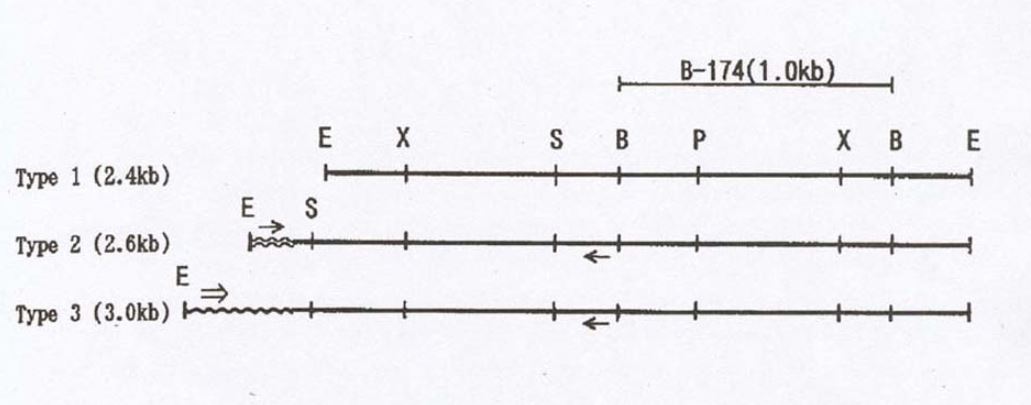Cucurbit Genetics Cooperative Report 21:6-7 (article 2) 1998
S. Matsuura and H. Mizusawa
Tohoiu Seed Company, 1625 Himuro, Nishihara, Utsunomiya 321-3232, Japan
K. Kadowaki
Department of Molecular Genetics, National Institute of Agrobiological Resources, Kannondai 2-1-2, Tsukuba, 305-0856, Japan
Introduction. In cucumber, we have reported that mitochondrial DNAs are inherited paternally in sexual propagation (1). Since this was revealed by RFLP analysis, we could not neglect the possibility of bi-paternal inheritance. In order to examine the above point, we investigated the DNA sequence of a mitochondrial DNA clone which was inherited paternally, and PCR analysis was performed subsequently using reciprocal hybrids.
Methods. One of the mitochondrial clones, B-174 (1.0kb) was sequenced. Based on this nucleotide sequence data, we applied the IPCR (Inverse PCR) for the self-ligated EcoRI digested total DNA of the cucumber lines, and the IPCR products were cloned by TA-cloning system and sequenced. The DNA sequence was determined by the dideoxy sequencing method. he parameters for PR reaction were 30 cycles of heating at 94 C for 15 sec. at 60 C for 15 sec and at 72 C for 2 min.
Results and Discussion. Southern blot hybridization analysis of EcoRI- digested genomic DNAs that were isolated from several cucumber varieties and the wild strain indicated five polymorphic single band patterns, 2.4kb (Type 1), 2.6kb (Type 2), 3.0kb (Type 3), 3.2kb (Type 4) and 3.7kb (Type 5), when the blots were probed with B-174. We have completed the cloning and sequencing for the three types: Type 1, Type 2 and Type 3 (part of the nucleotide sequence data have been submitted to the DDBJ, EMBL and GenBank with accession number D17360). The restriction maps of the three types of mitochondrial clones suggest that the polymorphisms resulted from the deletion at the neighbor region of the B-174 fragment (Fig. 1). Two sets of primers, primers A and K for Type 2 and primers W and K for Type 3 were designed which could detect the deletion sequence, and PCR detections were performed for the cucumber lines and their reciprocal hybrids. As shown in Fig. 2, the specific PCR amplification product was observed in each of the parental lines. In the reciprocal hybrids, PCR products were transmitted only from the paternal plant. These results strongly suggest that the mitochondrial DNA is inherited strictly in a paternal manner in cucumber.

Figure 1. Restrictive enzyme maps of the three types of mitochondrial clones. [B= BamHI; E = EcoRI; P = Pstl; S = Styl; X = Xbal; → = primer W; ← = primer K; – = homologous regions; ~ = non-homologous regions.]

Figure 2. Product of the PCR reaction from cucumbers lines and their reciprocal hybrids. [A = Aofushinari ( Japanese local variety, Type 2); W = W103 (hardwickii, Type 3); M = molecular marker (λ Hind III / Hinc II)]
Literature Cited
- Matsuura, S. 1995. Paternal inheritance of mitochondrial DNA in cucumber (Cucumis sativus L.) Cucurbit Genetics Cooperative Rept. 18:31-33.